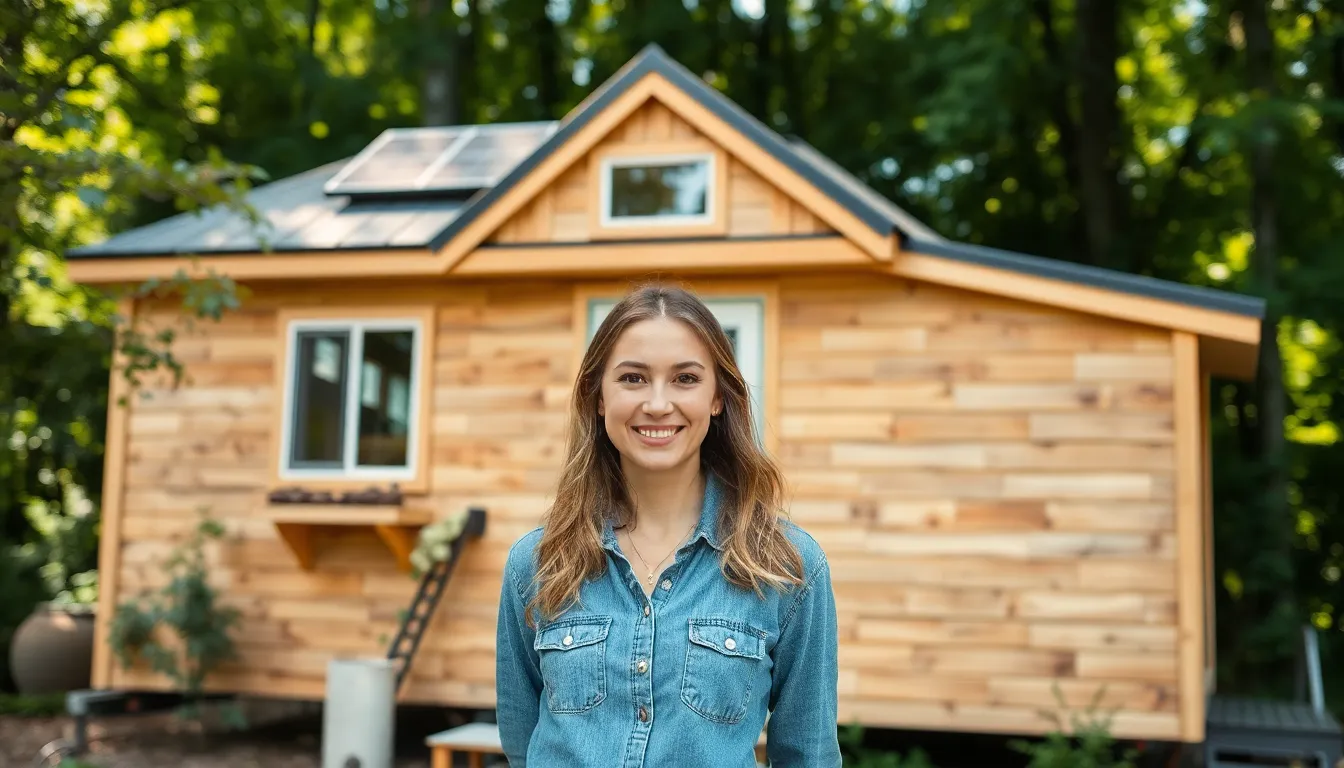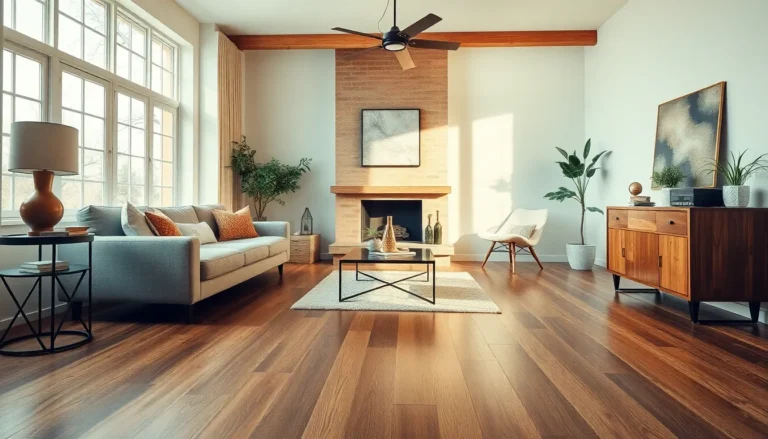Table of Contents
ToggleIn a world where bigger often seems better, tiny house kits are flipping the script. These compact wonders offer a charming solution for those seeking simplicity without sacrificing style. Imagine downsizing your life while upsizing your freedom—who wouldn’t want that?
Overview of Tiny House Kits
Tiny house kits simplify the construction of compact homes. These kits contain essential materials, pre-cut components, and easy-to-follow instructions. Many individuals find them easier than traditional construction methods. Convenience often attracts those new to homebuilding.
Affordability represents another significant advantage. Typical tiny house kits cost between $10,000 and $50,000, depending on the size and complexity. Budget-conscious buyers appreciate that they minimize expenses while maximizing functional living space. Reduced costs lead many to consider tiny living as a viable alternative.
Various designs cater to different preferences. Options include modern, rustic, and minimalist styles. Customers select kits based on aesthetics and functionality. Flexibility often becomes a deciding factor when choosing the right kit.
Time requirements for assembly vary. Generally, individuals can set up a tiny house in a few weeks to several months. The timeline largely depends on the homeowner’s experience and available resources. Many opt to hire contractors for faster completion.
Sustainability plays a crucial role in these homes. Tiny house kits often incorporate eco-friendly materials and energy-efficient technologies. Homeowners enjoy lower utility bills and a reduced environmental footprint. This approach aligns with growing consumer interest in sustainable living.
Do-it-yourselfers frequently embrace tiny house kits. Building from scratch empowers owners to customize their spaces. Creativity flourishes when individuals select finishes and layouts that reflect their personal style. Many consider the hands-on experience rewarding.
Overall, tiny house kits offer practical solutions for those pursuing simpler lifestyles. Their affordability, design options, and sustainability make them an attractive choice. Homeowners benefit from increased freedom and reduced living expenses as they transition to tiny living.
Advantages of Tiny House Kits

Tiny house kits offer standout benefits for those choosing a minimalist lifestyle. They provide accessible solutions, combining practicality with affordability and eco-friendliness.
Affordability
Affordability ranks high among the advantages of tiny house kits. Typical kits range from $10,000 to $50,000, making them budget-friendly options for many buyers. Lower construction costs significantly reduce the financial burden compared to traditional homes. Many people find they can bypass expensive materials and labor fees with these kits. Savings also extend to ongoing living expenses, as smaller homes typically require less maintenance and utility usage. Homeowners often discover that this financial flexibility leads to a more secure lifestyle choice.
Eco-Friendliness
Eco-friendliness is a notable advantage of tiny house kits. These kits frequently include sustainable materials that minimize environmental impact. Builders select energy-efficient technologies to enhance conservation, such as solar panels and composting toilets. Smaller living spaces automatically require fewer resources, resulting in lower overall emissions. Homeowners appreciate the ability to customize eco-friendly features to fit their lifestyle. Many kits cater to those committed to reducing their carbon footprint while still enjoying comfortable living spaces.
Types of Tiny House Kits
Tiny house kits come in various forms, each catering to different lifestyles and preferences. Understanding the distinctions helps homeowners choose the best fit for their needs.
Mobile Kits
Mobile kits, also known as trailer-based kits, allow for easy transport. Often, these designs feature lightweight materials and compact layouts, making them ideal for traveling. Homeowners can customize their spaces to include amenities such as kitchens and bathrooms while maintaining mobility. Many mobile kits meet road regulations and include trailer frames for seamless relocation. This flexibility attracts those seeking adventure or temporary living arrangements.
Stationary Kits
Stationary kits are designed for permanent placement on a foundation. These kits often boast sturdier materials to withstand various weather conditions, serving as enduring homes. With options for additional features like porches or loft spaces, the designs can accommodate a range of needs. Homeowners typically benefit from the chance to personalize their layout and aesthetics, creating a unique living space. Stationary kits are suitable for those preferring established locations, such as tiny house communities or private lots.
Considerations Before Purchase
Before buying a tiny house kit, potential owners should closely examine several important factors.
Zoning Laws
Zoning laws dictate where and how tiny homes can be constructed. Local regulations may restrict tiny house placement, especially in residential areas. Consulting local authorities can clarify permissible land use and any necessary permits. Some regions have specific requirements regarding size, foundation type, and utilities. Buyers should research community regulations to ensure compliance and avoid future complications. Understanding zoning laws helps prevent potential legal issues and promotes a smoother transition into tiny living.
Installation and Assembly
Installation and assembly of tiny house kits vary based on complexity and skill level. Many kits include comprehensive instructions, yet experience level influences assembly time, which can range from a few weeks to several months. Some individuals may opt for professional assistance to ensure structural integrity. Assessing personal skills and comfort with DIY tasks is crucial before starting the assembly process. Along with assembly, proper planning for utilities, such as plumbing and electricity, contributes to a successful setup. Considering these elements helps ensure a positive building experience.
Popular Tiny House Kit Brands
Several brands stand out in the tiny house kit market, each offering unique features and specifications. Tumbleweed Tiny House Company leads in providing customizable models, featuring designs that appeal to various lifestyles. Many enthusiasts appreciate the wide range of floor plans, which allow for personalized touches.
Mustard Seed Tiny Homes focuses on affordability without compromising quality. Kits come equipped with eco-friendly materials, making them an attractive choice for environmentally conscious buyers. Their approach to sustainable living resonates deeply with the tiny house movement.
Tiny Heirloom specializes in luxury tiny homes, showcasing top-notch craftsmanship and high-end finishes. Customers seeking elegance and style often gravitate toward their unique offerings. The combination of personalization options and premium materials enhances their appeal.
Green Tiny Homes stands out through its commitment to sustainability. Many kits in their lineup utilize reclaimed or recycled materials, reducing environmental impact. Buyers interested in eco-conscious living find significant appeal in such designs.
Shells and Co. markets kits for those preferring a DIY approach, offering easy-to-assemble structures. Detailed instructions accompany each kit, simplifying the building process for inexperienced builders. Their user-friendly options enable a rewarding construction experience.
FlatPack Tiny Homes makes a significant impact with their focus on functionality and compact living. Their designs maximize space efficiency, catering to individuals seeking practicality in their tiny homes. Many find their minimalist approach aligns with the principles of tiny living.
Brands continue to innovate, offering diverse options to meet the preferences and needs of tiny home buyers. Each manufacturer responds to the growing demand for simplicity and sustainability in contemporary living.
Tiny house kits present a transformative approach to modern living. They not only offer an affordable and sustainable housing option but also encourage a minimalist lifestyle that many are seeking today. With their diverse designs and customizable features, these kits cater to various preferences and needs.
As more individuals embrace the idea of downsizing, the appeal of tiny homes continues to grow. The accessibility of these kits simplifies the building process, making it easier for anyone to embark on their tiny living journey. By prioritizing sustainability and affordability, tiny house kits are paving the way for a new era of conscious living.







